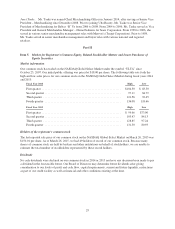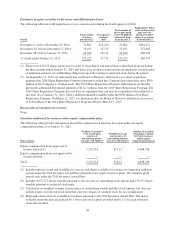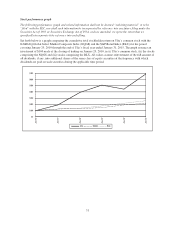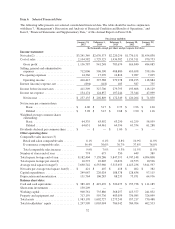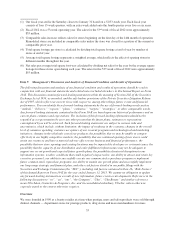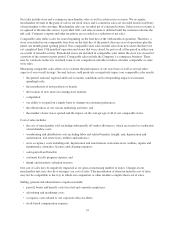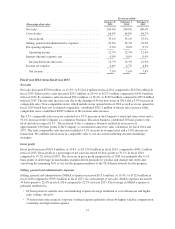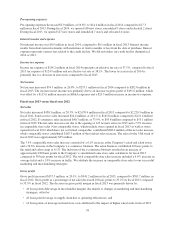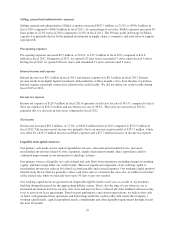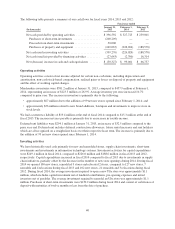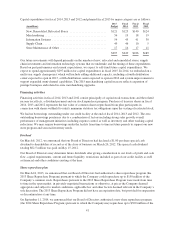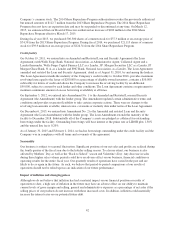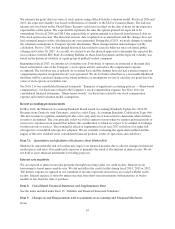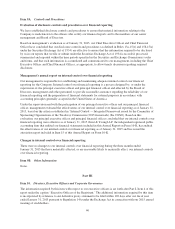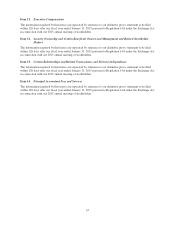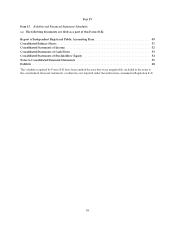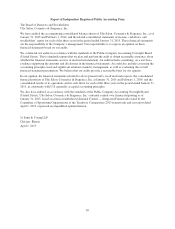Ulta 2014 Annual Report Download - page 43
Download and view the complete annual report
Please find page 43 of the 2014 Ulta annual report below. You can navigate through the pages in the report by either clicking on the pages listed below, or by using the keyword search tool below to find specific information within the annual report.Selling, general and administrative expenses
Selling, general and administrative (SG&A) expenses increased $107.5 million, or 22.0%, to $596.4 million in
fiscal 2013 compared to $488.9 million in fiscal 2012. As a percentage of net sales, SG&A expenses increased 30
basis points to 22.3% in fiscal 2013 compared to 22.0% in fiscal 2012. The 30 basis point deleverage in SG&A
expense was primarily driven by the planned investments in supply chain, e-commerce and store labor to support
rapid growth.
Pre-opening expenses
Pre-opening expenses increased $2.5 million, or 16.6%, to $17.3 million in fiscal 2013 compared to $14.8
million in fiscal 2012. During fiscal 2013, we opened 127 new stores, remodeled 7 stores and relocated 4 stores.
During fiscal 2012, we opened 102 new stores and remodeled 21 stores and relocated 3 stores.
Interest income and expense
Interest income was $0.1 million in fiscal 2013 and interest expense was $0.2 million in fiscal 2012. Interest
income results from highly liquid investments with maturities of three months or less from the date of purchase.
Interest expense represents various fees related to the credit facility. We did not utilize our credit facility during
fiscal 2013 or 2012.
Income tax expense
Income tax expense of $124.9 million in fiscal 2013 represents an effective tax rate of 38.1%, compared to fiscal
2012 tax expense of $107.2 million and an effective tax rate of 38.3%. The lower tax rate in fiscal 2013 is
primarily due to a decrease in state taxes compared to fiscal 2012.
Net income
Net income increased $30.3 million, or 17.6%, to $202.8 million in fiscal 2013 compared to $172.5 million in
fiscal 2012. The increase in net income was primarily due to an increase in gross profit of $157.5 million, which
was offset by a $107.5 million increase in SG&A expenses and a $17.7 million increase in income tax expense.
Liquidity and capital resources
Our primary cash needs are for capital expenditures for new, relocated and remodeled stores, increased
merchandise inventories related to store expansion, supply chain improvements, share repurchases and for
continued improvement in our information technology systems.
Our primary sources of liquidity are cash on hand and cash flows from operations, including changes in working
capital, and borrowings under our credit facility. The most significant component of our working capital is
merchandise inventories reduced by related accounts payable and accrued expenses. Our working capital position
benefits from the fact that we generally collect cash from sales to customers the same day, or within several days
of the related sale, while we typically have up to 30 days to pay our vendors.
Our working capital needs are greatest from August through November each year as a result of our inventory
build-up during this period for the approaching holiday season. This is also the time of year when we are at
maximum investment levels in our new store class and may not have collected all of the landlord allowances due
to us as part of our lease agreements. Based on past performance and current expectations, we believe that cash
on hand, cash generated from operations and borrowings under the credit facility will satisfy the Company’s
working capital needs, capital expenditure needs, commitments and other liquidity requirements through at least
the next 12 months.
39


